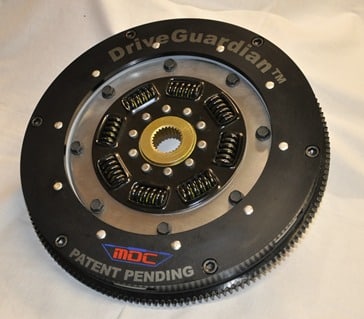
Mike Clesceri owns a 42-foot Fountain powered by Mercury Racing HP700 SCi engines with NXT transom assemblies and transmissions and Dry Sump Six drives. It’s an offshore boat and he wants to run it the way it was intended to be run, fast in sometimes less than ideal conditions.
“I boat on Lake Michigan and it’s rarely calm and I like to run hard,” he said. “I’d break something and I’d make it stronger, but it got to a point where I couldn’t make anything stronger.”
Transmissions, upper gear sets — name it and Clesceri broke it. “I broke my first NXT transmission in a poker run at 40 mph,” he recalled. He replaced the transmissions with Huber 1450s, but then he kept breaking upper gear sets in the drives. He had the drives rebuilt by Keith Holmes at CK Motorsports in Nunica, Michigan, but after paying those bills a couple of times, Clesceri got serious about looking for answers.
Clesceri is something of a self-trained mechanical engineer. He taught himself how to write software and he does all his own engine and mechanical work, and even draws up his own CAD designs. He makes a good living and has a business on the side called Marine Design Corp. (www.marinedesigncorp.com), so he vowed to come up with a way to keep his drives from breaking.
He rigged a strain gauge on his port engine and went for a ride in 2- to 3-foot seas on Lake Michigan in the middle of October in 2012 using a data logger to record the results. “I wish it was rougher that day, but that was the day I got to test,” Clesceri said. “You’re just hearing the engines go whoop, whoop and nothing.”
Then he looked at the data. Every time the boat left the water, when the port-side prop re-entered, the strain gauge was hitting almost 1,300 foot-pounds of torque for 60 to 80 milliseconds at a time. Multiply that by the number of times a boat leaves the water during a poker run, or just a relatively fast run to lunch, and it’s easy to see why equipment was having problems staying together. Clesceri added that it’s actually worse when you’re running at a mid-range rpm such as around 4,000 because when the prop comes out of the water, it accelerates to 5,400 before it re-enters, producing the load spike. When you’re already running at or near wide-open throttle, the deviations aren’t as great.
Clesceri explained that an added reason why performance boaters are having so many more mechanical issues is that propeller technology has advanced so much within the last five years. He runs six-blade Hering propellers on his boat, and with the increased number of blades compared with those on the popular Mercury Bravo One four-blade, there’s much more blade surface biting when they re-enter the water. This puts the added stress on the driveline and engine.
Armed with this information, Clesceri developed a way to decrease the loads on his engine and drivetrain and came up with the Drive Guardian, a torque-limiting clutch that looks like a motorcycle clutch pack. He recently earned a patent for the device, which replaces the stock MerCruiser or Mercury Racing drive coupler on a Bravo One where it attaches to the engine’s flywheel or where a Dry Sump Six or NXT links to a transmission. It’s made up of a series of plates made out of Kevlar, steel and other materials. When a boat is running in rough conditions at fast cruising or high speeds and the propellers come out of the water, the Drive Guardian absorbs the extra spikes in load as the props re-enter, preventing that added force from getting to the engine and driveline.
The DriveGuardian for a Bravo One retails for $2,495, about three times more than a stock coupler. Each unit must be calibrated to work with the engines in a given boat. For example, on his HP 700SCis, Clesceri set the Drive Guardian to kick in at 1,000 foot-pounds of torque because the engines will never generate that much. He’s also testing the product with a few teams in the Offshore Performance Association, including Smith Brothers Racing, Boxer Racing, a single-engine 26-foot V-bottom in Class 5, and Saris Racing, a twin-engine 32-foot Coyote in Class 4 powered by a pair of 700 hp engines. He’s also been consulting with the Spirit of Qatar offshore racing team, which is using some prototype Drive Guardians in its No. 13 catamaran powered by Mercury Racing 1650s with M8 drives.
Jason Saris builds the engines for and throttles the Saris Racing boat, and his team was the first to work with DriveGuardian. “It basically extends the life of our drives. Racing is an abusive activity and there is no such thing as bulletproof in racing, but it extends the life of our drives,” said Saris. “We should be able to get a full season out of a set of drives before we rebuild them.”
Clesceri said he hopes that having race teams test the product will validate his claims for the DriveGuardian’s capabilities, but he understands that there will always be doubters. “There are two camps of people I talk to about it,” said Clesceri. “One says, ‘I don’t believe you.’ And the other side says, ‘When can I get one?’”
His hope with the DriveGuardian has always been to make performance-boating safer and to help make engines and drives more reliable. “I’m not focusing on any product that’s going to make you go faster,” said Clesceri. “I’m 100 percent behind coming up with products that will make you comfortable and make the boats safer to run and more reliable.” In other words, they’ll let you run a performance boat the way it was meant to be run.
For more information, visit: www.marinedesigncorp.com.









